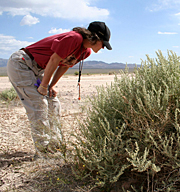- Number 312 |
- May 24, 2010
On the trail of the nuclides: SRNL’s Martine Duff

Dr. Martine Duff
Dr. Martine Duff of DOE's Savannah River National Laboratory has made a focus of her career the understanding of the nuclear fuel cycle. She is hot on the trail of the nuclides. The trail includes more than the mining, conversion, enriching, and burning of uranium fuel and the disposition and fate of nuclear materials.
“I want to understand all of the nuclides, the waste forms, how the nuclides end up in the environment, and in the biological systems,” she says. “I want to know why the nuclides are there, in what amounts, and what, if anything, to do about it.” In her work, Duff looks at the scientific roadblocks that currently hinder the advancement of national and homeland security from a unique perspective. In doing so, she challenges conventional wisdom.
It is not surprising that some of her recent work has been in the development of radiation detectors, particularly those made of cadmium zinc telluride (CZT) detectors. “As a material for room-temperature detectors, CZT crystals will be most advantageous if they can be manufactured in sufficient quantity and quality for reliable use. They could be excellent for several national and homeland security applications”
One of the factors restricting CZT quality are the imperfections that were generally held to be Te inclusions and Te precipitates. “According to theory, these imperfections were assumed to be Te-containing precipitates or inclusions, but no one had determined experimentally what sort of material was in the imperfections.” For example, Duff found that ‘precipitates’ were more transparent to synchrotron-based X-rays than you would expect. In a paper published last year, Duff and others showed that inclusions and precipitates (now termed secondary phases) in one type of CZT material were generally voids with residues of Si, Cd, Zn and Te, and composites of metallic Te with cores of amorphous and polycrystalline CdZnTe and Te material. “A better understanding of how the problems influence material performance should help make better crystals.”
Looking at the scientific roadblocks with new perspectives has made her a key participant in forensics work at SRNL. SRNL has a long record of developing technologies of use to law enforcement. In the last few years, SRNL has entered formal agreements with various agencies to help examine evidence, and train law enforcement officers and forensic examiners to work with evidence, that has been contaminated with radioactive materials.
“The trick is to safely enable the examination of the radiological evidence while preserving the forensic integrity of the evidence,” Duff says. “If you put the evidence in a rad hood, for example, the forensic examiner is protected but hairs and fibers go out the exhaust. We’ve developed innovative techniques that apply our expertise in handling contamination to suit law enforcement’s needs.” Duff and researchers at SRNL have developed a large variety of PVC glove bags and other containments to permit microscopy, photography, latent print enhancement, tool-marks and questioned document examinations with items with low to high contamination levels, and also has facilities available that enable examination of evidence with high radiation dose rates.
Duff received her Ph.D. from the University of California-Riverside in soil and environmental sciences and later completed a post doctoral study at Los Alamos in 1998. She first came to the Savannah River Site to work at the Savannah River Ecology Laboratory (University of Georgia), all of which underscores her interest in the fate of radionuclides in the environment. One expression of that interest is her recently-completed 260-page field guide, complete with color photos, for those who would identify radionuclides in the environment. Heretofore, similar guides had existed for chemicals and biohazards, but not for radioactive materials in biological organisms. “There may be follow-on work engineering plants for enhanced metal bioaccumulation,” she says, “which could have various applications like environmental cleanup.”
Generally speaking, Duff wants her work to help the ever changing needs of our society, and wants to mentor rising researchers to the same end. “We need to continue to build a foundation of up and coming researchers in the nuclear scientific and engineering fields.”Submitted by DOE's Savannah River National Laboratory
